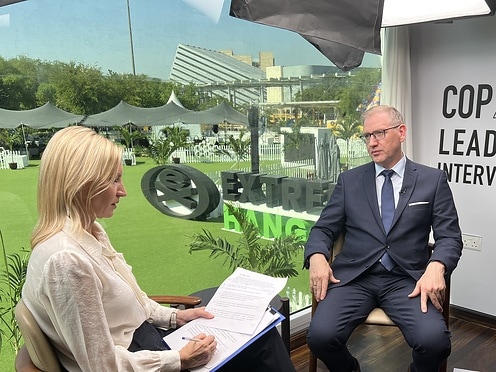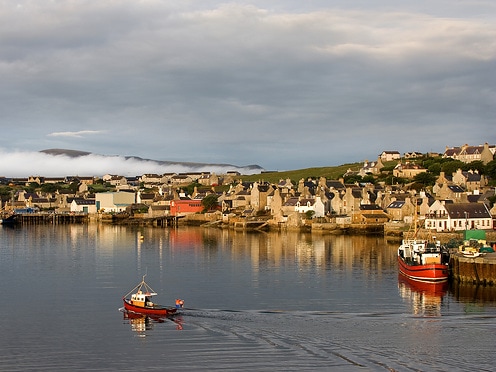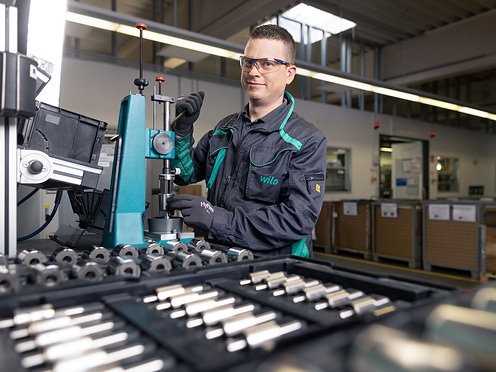Saving energy wherever possible: Six examples
Saving energy is the order of the day. Extraordinary ideas and approaches that make a difference are also vital. This is shown by some of these six examples from around the world – in shopping, in shipping and even from the animal kingdom.
This text is part of Wilo's annual report 2022.

1. On the oceans
How can the fuel consumption of large ships such as tankers or bulk carriers for ore, coal or grain be reduced? Engineers Friedrich Mewis and Dirk Lehmann dealt with this question about 15 years ago. Their answer was to mount a large, round metal device in front of the ship’s propeller, up to seven metres in diameter and weighing up to 60 tonnes, the Becker Mewis Duct. This duct influences the flow path and thus reduces the propeller’s loss of rotation. This results in more propulsion with the same drive power and thus less fuel consumption. The individual components of the system already existed before, but Mewis and Lehmann combined them in a novel way. This allowed ships to reduce their fuel consumption by 3 to 8 per cent. Around 1,400 ships have now been equipped with the technology, and a further 300 are about to have it installed. The invention has resulted in a reduction of around 12 million tonnes of CO2 since 2009 – as much as is released in Hamburg in one year. The two engineers won the German Environmental Award last year for their invention.
2. In shopping
The world’s most energy-efficient supermarket is in Oulu, Finland. “A normal supermarket needs around 600 kilowatt hours of electricity per square metre per year. Our energy-saving pilot supermarket only needs 240 kilowatt hours”, explained one of the managers at the project launch in 2017. That is only about 40 per cent of the normal consumption of supermarkets and not much more than the average old flat would need. Half of the electricity comes from a solar installation on the supermarket’s roof. This has significantly reduced energy costs by around 180,000 euros per year. The supermarket chain ran the project together with the Technical Research Centre of Finland and subsequently set up several low-energy supermarkets in the region. A second phase of cooperation in 2022 focused on heat supply. This involves the chain using the waste heat from the cooling units of one of its supermarkets and feeding it into the mains. This has huge potential: the waste heat from a supermarket is enough to heat 150 single-family homes.
3. In evolution
Sloths are frugal: instead of foraging for fruits or other energy-rich food, they mainly eat leaves with a very low nutrient content. In order to be able to survive despite this, they have developed into true energy-saving champions through evolution. They spend three quarters of their time snoozing. According to the Zurich Zoo, they only cover about 40 metres per day during their waking hours, with an average speed of 0.54 kilometres per hour. In addition, they can adapt their body temperature to their surroundings. This also helps them save energy. Zoologists at the Friedrich Schiller University Jena have studied the anatomy of the animals. They have discovered other special features that help them save energy: thanks to long arms and short, freely moving shoulder blades on a narrow chest, sloths have a maximum range of motion. And a shift in the insertion points of certain muscles allow them to hold their own body weight with minimal effort. All this contributes to the fact that they have the lowest metabolic rate of all non-hibernating mammals. In relation to their body size, it should actually be twice as great. Perhaps they should be called “frugals” instead of “sloths”.
4. On tour
For their world tour in 2022, the British band Coldplay set themselves an ambitious goal of halving direct emissions compared to the tour in 2016 and 2017. For the power supply, solar panels were set up in and around the stadiums to charge a battery system specially developed for the tour. The band also used a kinetic floor in the audience. Fans dancing on it generated some of the energy for the stage show. This was based on particularly energy-saving light and sound systems. The band also had an app programmed to motivate fans to cycle, walk or take public transport to the concerts. Anyone who came to the concert using environmentally friendly transport was rewarded with a voucher. The first concert of the tour took place in Costa Rica. This is no coincidence: the aim was for electricity purchased for the tour to come entirely from renewable energies – as in Costa Rica, where 99 per cent of energy is generated from renewable sources.
5. On three wheels
How energy-efficient can a vehicle be? Several generations of students at the Technical University of Munich have already attempted to answer this question. In the TUfast Eco Team, they are working on vehicles with minimal energy consumption – and in 2016, they even broke the world record for the most efficient electric vehicle in the world. The three-wheeler, whose shape is reminiscent of a cigar and which is driven lying down, consumed only 81.16 watt hours of electricity over a distance of 100 kilometres. With just one litre of premium petrol in the tank, it could cover around 11,000 kilometres. The Munich students lost the world record to a US team in 2019. However, they continue to work with air and rolling resistance and are now building vehicles in which the driver sits upright. These are also very economical on the road: in an international competition for the most economical car, the team took second place and won three out of four special awards.
6. In pump technology
Old, uncontrolled pumps are in use all over the world. And they consume much more electricity than their highly efficient successors. Worldwide, up to 246 terawatt hours in electricity for heating, cooling and air-conditioning applications alone could be saved if outdated pumps were replaced by the latest generation models – that is equivalent to the capacity of around 80 medium-sized coal-fired power plants that would no longer be required. Pump replacement makes a big difference. How big exactly? An example shows that: The Wilo-Stratos PICO as a new central heating pump installed in detached and semi-detached houses can save up to 80 percent electricity compared to an uncontrolled pump. That is a real energy saving – right up to the limit!


















